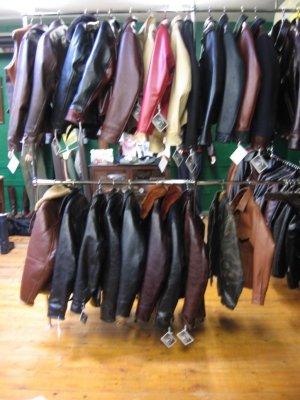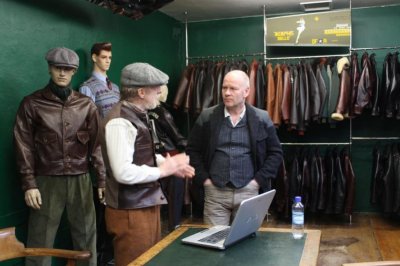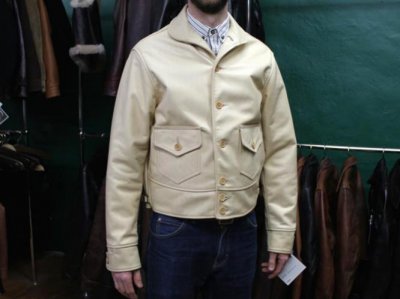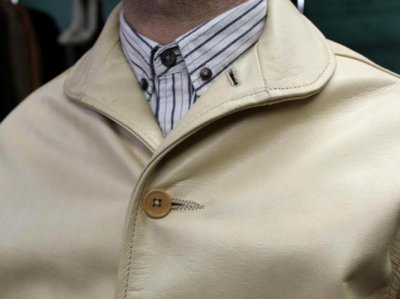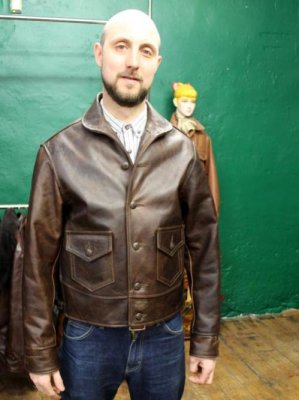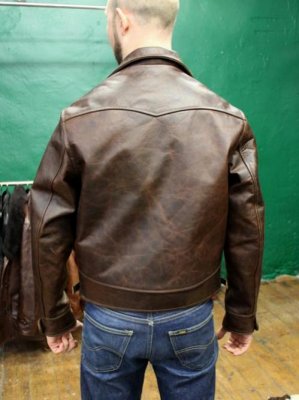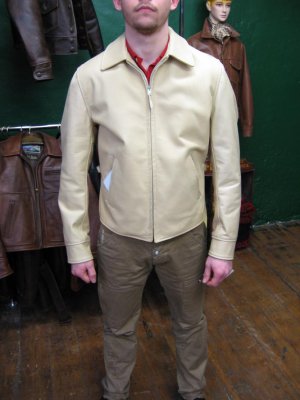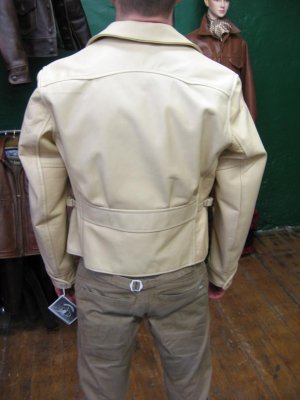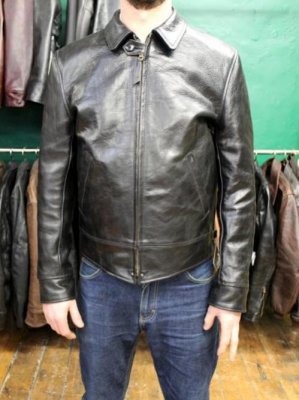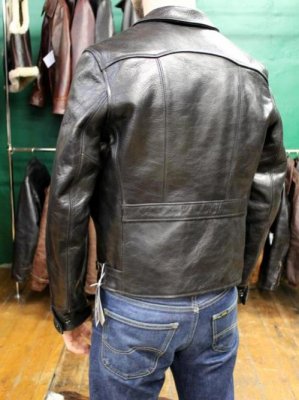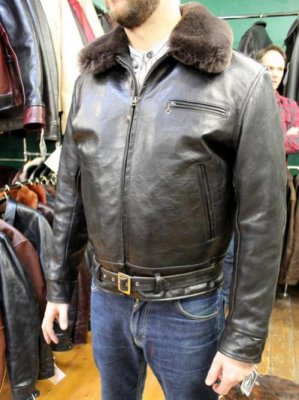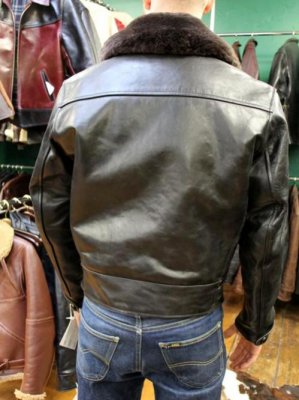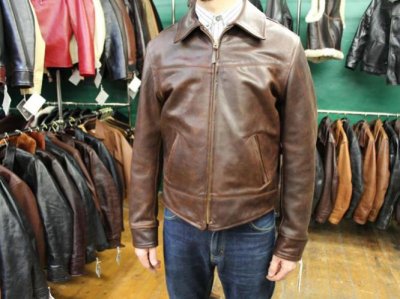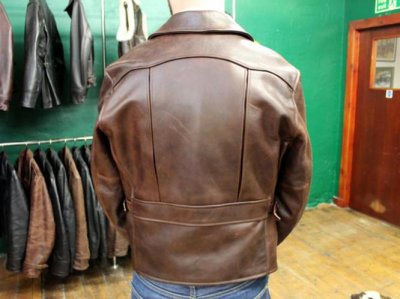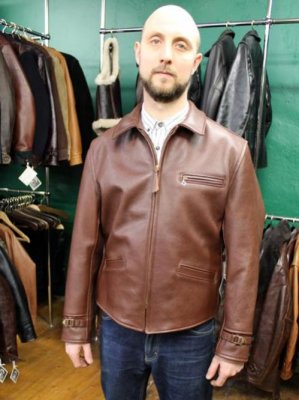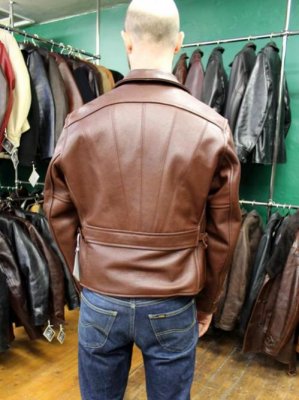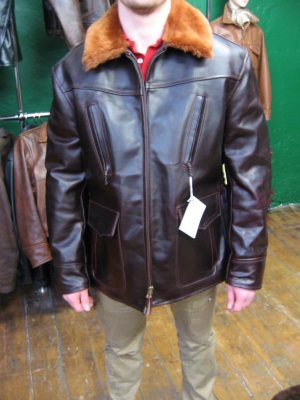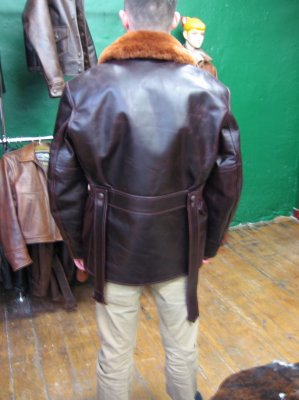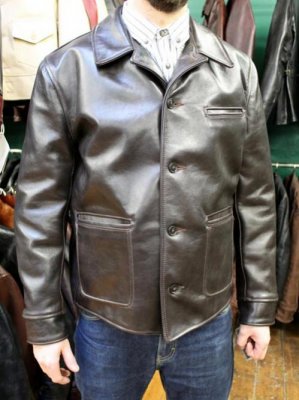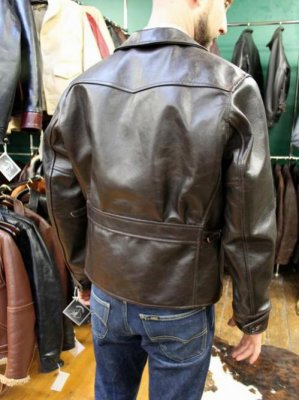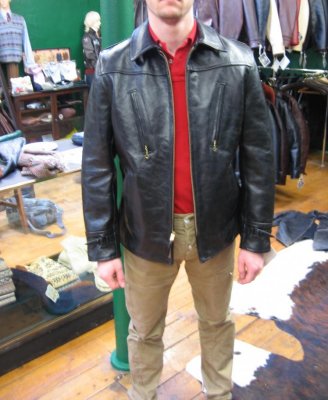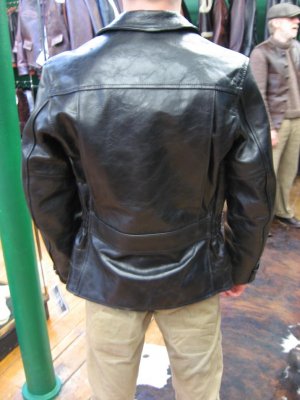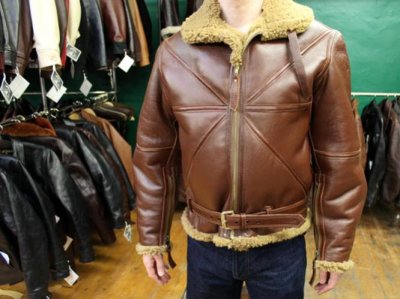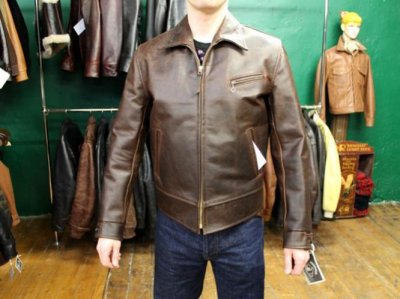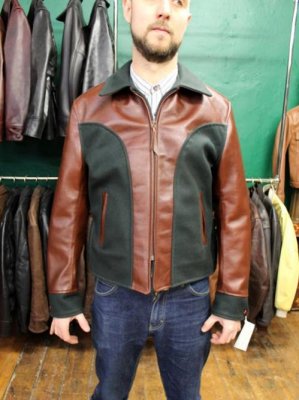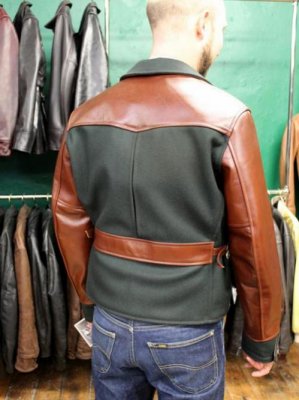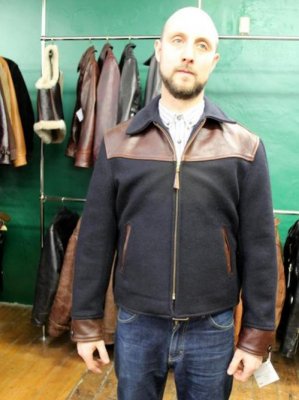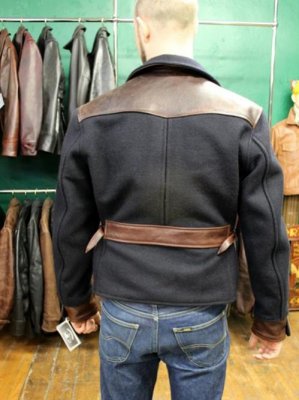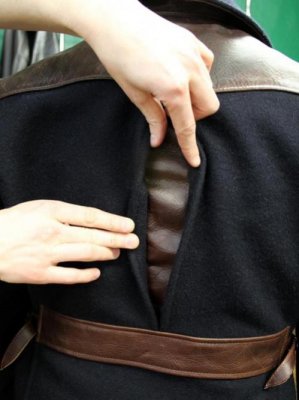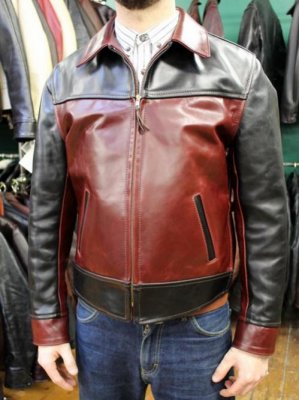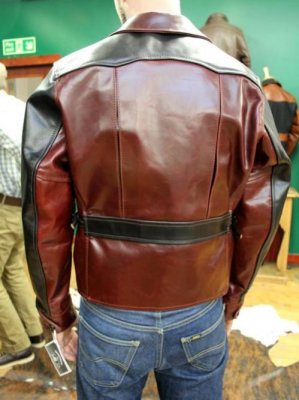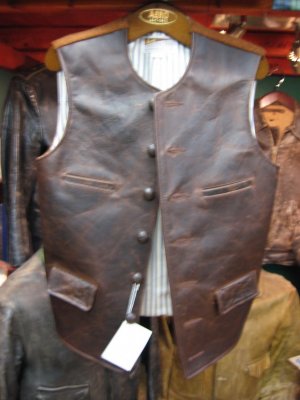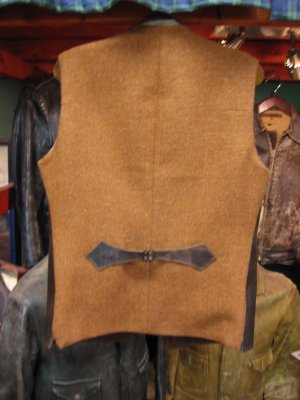Fedora Lounge Features
News and Views
- Messages
- 3
- Location
- Sniffing out stories.
Fedora Lounge Features - Report from Aero Leather Trade Week
By Craig Brown
The prospect of the Aero’s first trade in its 30 year history, launching a slew of new designs, has caused fans of their jackets to get back in touch with their inner child – specifically, the way they felt the night before Christmas. In a niche sector where even a new type of hide is a talking point, the simultaneous launch of 16 new designs from Aero is pretty much unprecedented. The suspense has been killing me too, so a chance to preview Aero’s new treasures at their Galashiels HQ is like getting invited to Santa's grotto and allowed to have a good old rummage.
But I'm not alone. Invited? Yes. Unfettered access? Pretty much.
But allowed to descend into leather-bound mania? Sadly, no. Aero's founder, Ken Calder, is sitting behind his desk in the newly decorated sale room, talking serious business with traders in heavily cuffed jeans . Some have travelled from as far as Japan to see what’s in the offing. Cutting a dash in a Harris wool jumper, a leather waistcoat (more of which later), houndstooth trousers and a baker's boy cap, Ken occasionally breaks off to discuss the details of a jacket with Hiro from Aero Japan, advise a passing staff member, or check his dog Cally is happy. She is.
The pair of shop dummies standing guard behind him in the latest jackets look pretty jaunty too. At the opposite side of the room, another mannequin swaddled in Aero's new-design Irvin, could almost be sweating slightly.
The new designs hang tantalisingly from a double rack, with little white tags bearing their names.
Holly, Ken's daughter and integral part of the Aero machine, appears at my side: "They’re all there, help yourself, any questions, just ask.”
I do believe my hands are shaking slightly, but here goes...
So, first impressions of the collection: Ken seems to have sought inspiration in the 1920s and 30s. Many would not look out of place on the set of Boardwalk Empire , with an emphasis on period details such as detachable belts, elasticated side gussets, hookless zips, moleskin as standard on handwarmer pockets. There’s a mix of fabrics and leathers, and restyled buckles, which will perhaps end the perennial complaint about slipping cinch straps.
Of all the new designs, the Aeromarine has attracted the most attention online so far: up until now the model has been pretty much the preserve of Japanese jacket makers, putting it out of the price range of many western buyers. Aero’s version is striking with its shawl collar and proto-A-1 styling. Close fitting with high armholes and low-slung waist adjusters that give it a straight-up-and-down feel, it’s based on a 1920s jacket that has sat in the factory archive for some 15 years. Early plans for this style to include a zip have been shelved for now, but might be revived in future.
Beyond it’s ‘what’s that?’ styling, the Aeromarine hide choices also stand out - not least the shank tanned cream horsehide, a soft, buttery leather, and the enigmatic ‘battered brown horsehide’, similar to oil pull in texture, but with a strong grain, by dint of the light base and dark top coat, that changes the patina with every crease. The two hides give very different emphasis to the character of the basic jacket, the cream lends a slightly ‘dressy’ feel, while the ‘battered brown’ has a more utilitarian look. You pays your money, you make your choice. The cream horsehide makes a second appearance for the Hollywood. A lighter, slim version of the ubiquitous 30s Half-Belt, this one won’t stand up by itself when you take it out of the box.
Another model that has loitered in Aero’s archives for years is the Original Hercules. Unlike its perennially popular brother, the Original Hercules is a short, neat jacket, lacking the more striking elements such as the front cording and distinctive curved pocket flaps. Lined in cord and with moleskin in the sleeves, the jacket has a more subtle styling: cinch belts virtually set on the hips, triple stitching on the seams, a throat latch, hookless zip and a three panel back.
The third recreation of a vintage design is the Thunder Bay. A model that appeared on the sale page late last year, it’s based on Ken’s own jacket, which was worn and repaired until it could take no more and then retired to Aero’s archives. Despite having examined this one on my laptop since it first debuted, in the flesh, so to speak, the Thunder Bay is even more impressive in reality: something akin to a biker-style jacket with a thick shearling and mouton collar (the rust on black is a particularly nice combo), the cord lining, stud cuffs and belted waist effectively seal out the elements.
By Craig Brown
The prospect of the Aero’s first trade in its 30 year history, launching a slew of new designs, has caused fans of their jackets to get back in touch with their inner child – specifically, the way they felt the night before Christmas. In a niche sector where even a new type of hide is a talking point, the simultaneous launch of 16 new designs from Aero is pretty much unprecedented. The suspense has been killing me too, so a chance to preview Aero’s new treasures at their Galashiels HQ is like getting invited to Santa's grotto and allowed to have a good old rummage.
But I'm not alone. Invited? Yes. Unfettered access? Pretty much.
But allowed to descend into leather-bound mania? Sadly, no. Aero's founder, Ken Calder, is sitting behind his desk in the newly decorated sale room, talking serious business with traders in heavily cuffed jeans . Some have travelled from as far as Japan to see what’s in the offing. Cutting a dash in a Harris wool jumper, a leather waistcoat (more of which later), houndstooth trousers and a baker's boy cap, Ken occasionally breaks off to discuss the details of a jacket with Hiro from Aero Japan, advise a passing staff member, or check his dog Cally is happy. She is.
The pair of shop dummies standing guard behind him in the latest jackets look pretty jaunty too. At the opposite side of the room, another mannequin swaddled in Aero's new-design Irvin, could almost be sweating slightly.
The new designs hang tantalisingly from a double rack, with little white tags bearing their names.
Holly, Ken's daughter and integral part of the Aero machine, appears at my side: "They’re all there, help yourself, any questions, just ask.”
I do believe my hands are shaking slightly, but here goes...
So, first impressions of the collection: Ken seems to have sought inspiration in the 1920s and 30s. Many would not look out of place on the set of Boardwalk Empire , with an emphasis on period details such as detachable belts, elasticated side gussets, hookless zips, moleskin as standard on handwarmer pockets. There’s a mix of fabrics and leathers, and restyled buckles, which will perhaps end the perennial complaint about slipping cinch straps.
Of all the new designs, the Aeromarine has attracted the most attention online so far: up until now the model has been pretty much the preserve of Japanese jacket makers, putting it out of the price range of many western buyers. Aero’s version is striking with its shawl collar and proto-A-1 styling. Close fitting with high armholes and low-slung waist adjusters that give it a straight-up-and-down feel, it’s based on a 1920s jacket that has sat in the factory archive for some 15 years. Early plans for this style to include a zip have been shelved for now, but might be revived in future.
Beyond it’s ‘what’s that?’ styling, the Aeromarine hide choices also stand out - not least the shank tanned cream horsehide, a soft, buttery leather, and the enigmatic ‘battered brown horsehide’, similar to oil pull in texture, but with a strong grain, by dint of the light base and dark top coat, that changes the patina with every crease. The two hides give very different emphasis to the character of the basic jacket, the cream lends a slightly ‘dressy’ feel, while the ‘battered brown’ has a more utilitarian look. You pays your money, you make your choice. The cream horsehide makes a second appearance for the Hollywood. A lighter, slim version of the ubiquitous 30s Half-Belt, this one won’t stand up by itself when you take it out of the box.
Another model that has loitered in Aero’s archives for years is the Original Hercules. Unlike its perennially popular brother, the Original Hercules is a short, neat jacket, lacking the more striking elements such as the front cording and distinctive curved pocket flaps. Lined in cord and with moleskin in the sleeves, the jacket has a more subtle styling: cinch belts virtually set on the hips, triple stitching on the seams, a throat latch, hookless zip and a three panel back.
The third recreation of a vintage design is the Thunder Bay. A model that appeared on the sale page late last year, it’s based on Ken’s own jacket, which was worn and repaired until it could take no more and then retired to Aero’s archives. Despite having examined this one on my laptop since it first debuted, in the flesh, so to speak, the Thunder Bay is even more impressive in reality: something akin to a biker-style jacket with a thick shearling and mouton collar (the rust on black is a particularly nice combo), the cord lining, stud cuffs and belted waist effectively seal out the elements.
